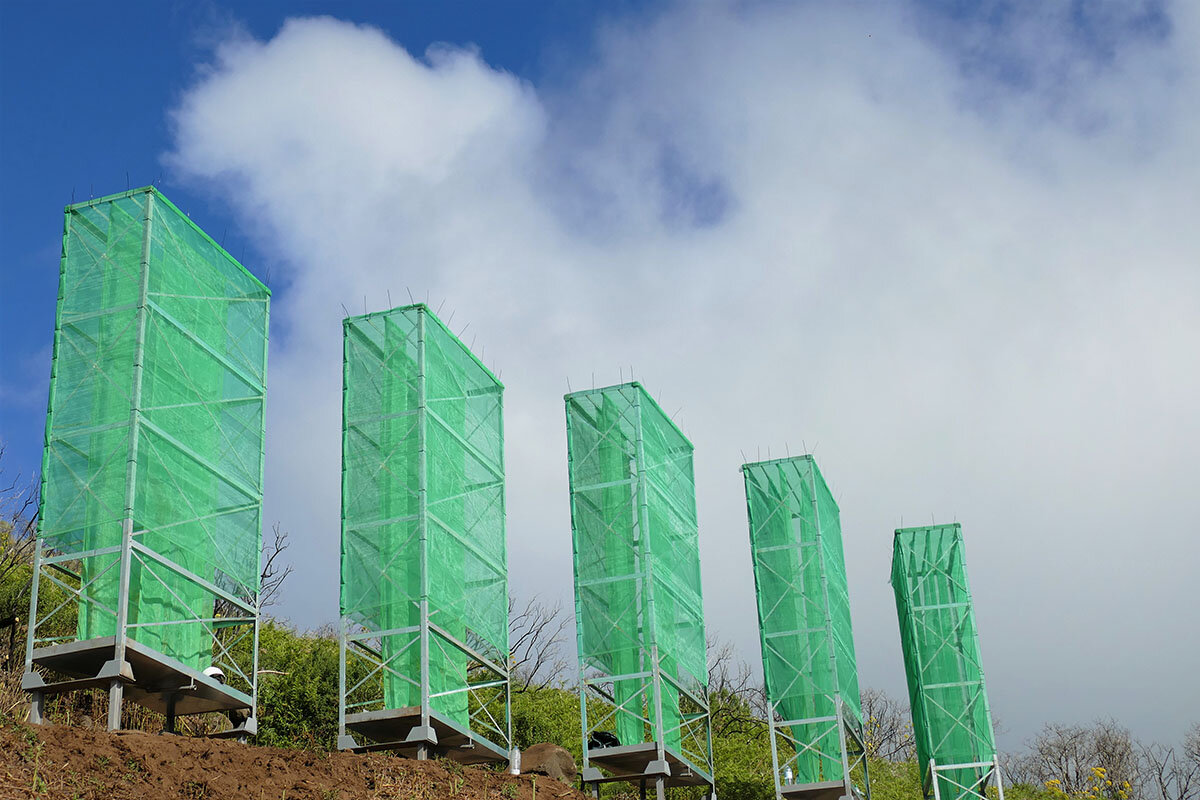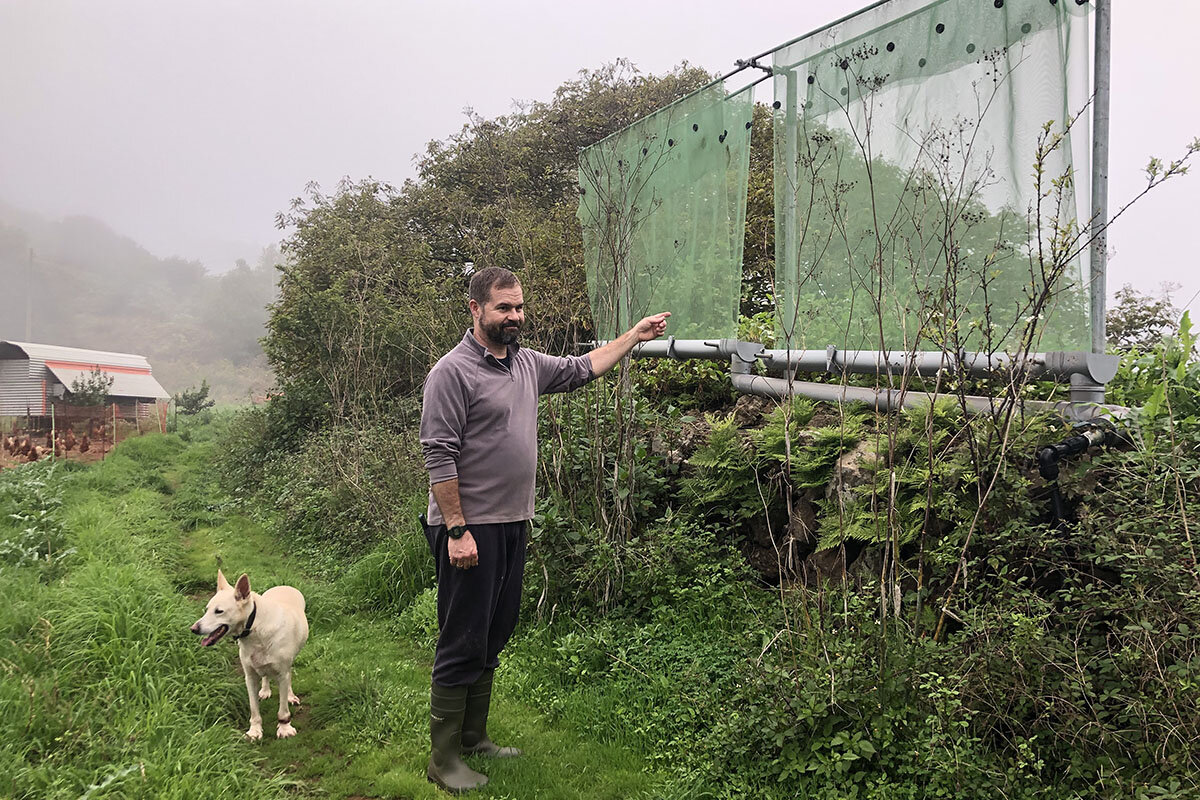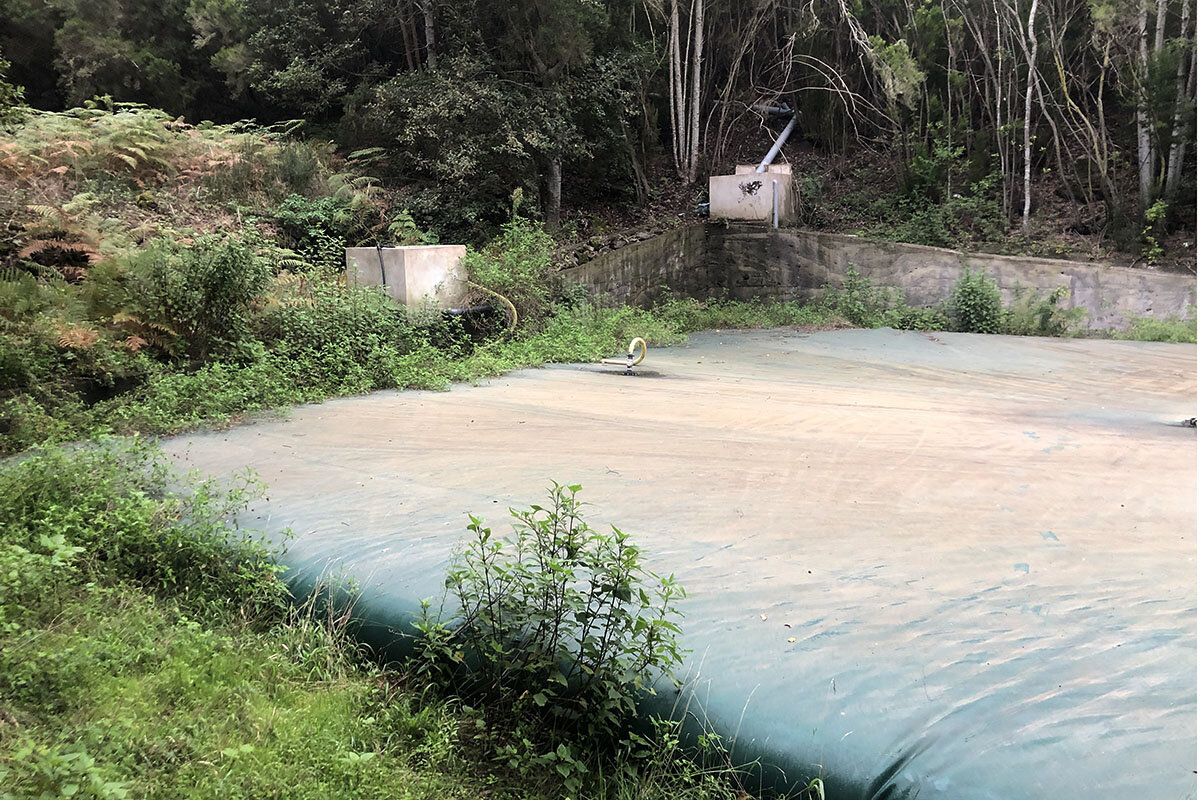Farming fog for water? Canary Islands tap a new reservoir.
Loading...
| La Vega, Spain
On a clear day, the tiny hamlet of La Vega, stacked up high on the hillsides of northern Tenerife, offers spectacular views of the rugged Atlantic coast. But this afternoon, the thick mist spiraling through Jonay González Pérez and Sara Rodríguez Dorta’s farmland sets an eerie Alfred Hitchcock filmlike scene.
Nearly ripe for fog harvesting.
“There’s almost enough fog to start collecting it,” says Mr. González Pérez, trudging through ankle-high grass in rubber galoshes as he snaps dead leaves off an artichoke plant. “But we need to wait a little longer, until the fog is at the same level as the catcher.”
Why We Wrote This
A lack of usable water is becoming a problem in areas where it wasn’t before, due to climate change. But in the Canary Islands, locals are finding that fog can make up for shortfalls on farms.
Since 2018, Mr. González Pérez and his wife have relied solely on fog collecting to water their 3.7 acres of farmland – which includes lemon and plum trees, artichoke plants, and 50 chickens – when rain is in short supply in the summer months.
On a good day, the couple’s 435-yard-long wall of collectors – vertical U-shaped nets cemented into the ground by metal poles – can harvest 475 gallons of water. The suspended fog droplets fall from the nets and flow through 220 yards of black tubing, which snake down the back of their property into a 95,000-gallon storage tank that resembles a giant waterbed.
Their system – which the couple built with their bare hands over the course of a year – was entirely paid for through government subsidies, after they won a local award for the best initiative in rural farming.
But this isn’t just a pet project for small-scale farmers. In 2020, the European Commission partnered with the local government in neighboring Gran Canaria to fund the fog-collecting project, which aims to reforest areas decimated by drought or forest fire. Harvested fog water meets the World Health Organization’s standards on drinking water safety and has provided isolated communities with a much needed resource for decades.
As the Canary Islands and regions around the world look to combat the effects of climate change, fog collecting is becoming an increasingly viable technology for communities facing soil erosion and water supply challenges.
“Fundamentally, we depend on our groundwater in the Canary Islands and water is always scarce,” says María Victoria Marzol Jaén, a retired climate scientist at the University of La Laguna on Tenerife and one of the pioneering researchers into fog collecting in the Canary Islands in the 1990s.
“Fog water alone can’t supply this, but it can be useful for reforestation purposes, like in the case of forest fires. But for rural zones, where water consumption is much lower, [fog collecting] is more than just helpful. It can be the solution to water problems.”
“We have a natural resource right in front of us”
The first documented experiments into fog as an alternative water resource can be traced to South Africa in the early 1900s. In 1963, Chilean physicist Carlos Espinosa’s invention of “mist traps” were patented and offered to UNESCO for free use around the world. Since then, researchers have made significant developments into the green technology, and research sites can be found in Chile, Peru, South Africa, Morocco, China, the United States, and Spain’s Canary Islands.
Due to their high altitudes and abundance of fog – in addition to their unique water supply challenges – the Canary Islands have remained at the center of fog harvesting research, particularly Tenerife and Gran Canaria.
Though there are slight variations, most fog harvesting systems follow a similar model to the one built by Mr. González Pérez and his wife, involving two or more nets that catch the fog droplets, which then drip into a waiting container.
Apart from the initial materials and building costs, fog collection is a low-energy operation, whose structures, like netting, can blend more seamlessly into natural environments than wind turbines or solar panels. Upkeep involves merely clearing away overgrown plants and cleaning the filters.
“Fog collecting doesn’t consume any energy and doesn’t affect any other natural resources,” says Ricardo Gil, a technical architect in Tenerife who runs the Nieblagua company. He has installed around 100 fog collectors across the Canary Islands, mainland Spain, and Portugal. “It also takes the pressure off extracting water from aquifers or desalinating ocean water.”
Each of Nieblagua’s catchers can withstand winds of up to 62 mph, and use four sheets of netting to collect up to 8,000 gallons of water per year in optimum conditions. In several of the Canary Islands, which benefit from around five hours of fog per day, this translates to almost one person’s entire water needs – the World Health Organization estimates that (13 to 26 gallons) of water is necessary for one person’s basic daily usage.
For thirsty, drought-stricken regions, that can mean the difference between survival and desertification – especially when multiple catchers are set up in one area. In Arafo on Tenerife, 12 of Nieblagua catchers provide an estimated 26,000 gallons annually to new almond tree plantations.
“It’s not a fantasy. We’re using up our natural resources all around the world,” says Mr. Gil during a coffee break in La Laguna. “Here we have a natural resource right in front of us. We need to take advantage of it.”
“Very useful on a small scale”
Fog is often referred to as “horizontal rain,” but collecting it has its limitations and relies on certain conditions to function. There has to be enough wind to push the droplets through the nets, but not too much that it knocks the whole structure down. And, of course, there has to be enough fog.
In recent years, weather patterns have become more erratic due to climate change, making the quantity and quality of periods of fog more unpredictable and, thus, more unreliable when it comes to harvesting efforts.
“Fog collecting can only be done in very specific conditions. Mountain ranges are best,” says Axel Ritter Rodríguez, an agroforestry engineering professor at the University of La Laguna and a researcher with the Life Nieblas project. “I don’t think it’s the remedy to all of our water problems, but it’s very useful on a small scale.”
The Life Nieblas project has taken this scaled-down approach, but with a broader vision for the future. Project members have installed 15 of Nieblagua’s catchers in Gran Canaria with the goal of harvesting 57,000 gallons of fog water in a year to repopulate 86 acres of the Doramas Forest with 20,000 laurel trees. The area is at high risk of desertification due to forest fires.
Researchers at Life Nieblas are also developing a separate system that resembles a wind tunnel “to contribute to our fog collection knowledge,” says Dr. Ritter Rodríguez.
As the Canary Islands and the Spanish peninsula look forward, they can expect more irregular and intense periods of rain, in addition to an increase in extreme weather events such as heat waves and storms, says Jorge Olcina Cantos, a geographer at the University of Alicante. “Temperature-wise, it’s going to become less comfortable,” he says.
That has made new, energy-efficient technologies ever more important when it comes to finding water solutions. Research is also continuing into dew collection, which uses a similar system of catching condensation via horizontal nets.
The overarching goal is to stay one step ahead of the game, which means anticipating water and soil needs before they become a problem. Mr. González Pérez and Ms. Rodríguez Dorta knew that when they first got started as young farmers five years ago. Even though their soil is meant for growing apple and pear trees, they decided to plant lemon trees instead, which benefit from a more arid climate.
“We spent about a year thinking and planning this farm. When we bought the land, there had just been forest fires 100 meters [109 yards] away that had destroyed the area,” says Mr. González Pérez. “We could already see that climate change was going to affect things going forward. ... We’re in an area where the local authority does not supply water for agricultural use. So without the fog collectors, our farm simply would not exist.”







